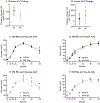Timing of resistance exercise and cardiometabolic outcomes in adults with prediabetes: a secondary analysis
- PMID: 39773011
- PMCID: PMC12182900
- DOI: 10.1152/japplphysiol.00507.2024
Timing of resistance exercise and cardiometabolic outcomes in adults with prediabetes: a secondary analysis
Abstract
The objective of this study was to explore whether the time of day (AM vs. PM) resistance exercise is performed influences glucose and insulin concentrations, body composition, and muscular strength in adults with prediabetes. A secondary data analysis was conducted using data from the "Resist Diabetes" study, a phase II exercise intervention. Participants (age: 59.9 ± 5.4 yr; BMI: 33 ± 3.7 kg/m2) with prediabetes and overweight or obesity were categorized into AM (n = 73) or PM (n = 80) exercisers based on when they completed all of their supervised exercise sessions during a 12-wk, 2×/wk resistance exercise intervention. Blood glucose and insulin derived from oral glucose tolerance tests, body composition, and muscular strength were assessed pre- and post resistance exercise training. Inverse propensity score weighting approach was used to estimate the efficacy of AM versus PM exercise on the change of clinical responses. Paired samples t test was used to compare pre-/post-outcomes within AM and PM groups. No differences between AM and PM exercisers were detected in the change in glucose or insulin area under the curve (AUC), body composition, or muscular strength. When exploring within-group changes, PM exercisers reduced glucose AUC (change: -800.6 mg/dL·120 min; P = 0.01), whereas no significant change was detected for AM exercisers (change: -426.9 mg/dL·120 min; P = 0.26). Only AM exercisers increased fat-free mass (change: 0.6 kg; P = 0.001). The time of day resistance exercise is performed may have some impact on glucose concentrations and body composition response. Future randomized clinical trials are needed to understand how exercise timing influences cardiometabolic outcomes in at-risk adults.NEW & NOTEWORTHY In this secondary analysis, there was no difference between AM and PM exercisers in blood glucose, insulin, body composition, or muscular strength following 12 wk of supervised exercise. However, examining within-group changes, glucose area under the curve (AUC) was significantly reduced in PM exercisers, but not in AM exercisers.
Keywords: aging; exercise timing; prediabetes; resistance exercise.
Copyright © 2025 The Authors.
Figures


References
-
- Weisman A, Fazli GS, Johns A, and Booth GL. Evolving Trends in the Epidemiology, Risk Factors, and Prevention of Type 2 Diabetes: A Review. Can J Cardiol 34: 552–564, 2018. - PubMed
MeSH terms
Substances
Grants and funding
- UL1 TR002538/TR/NCATS NIH HHS/United States
- KL2 TR002539/TR/NCATS NIH HHS/United States
- 5KL2TR002539/HHS | NIH | National Center for Advancing Translational Sciences (NCATS)
- 5K01HL145099/HHS | NIH | National Heart, Lung, and Blood Institute (NHLBI)
- R01DK082383/HHS | NIH | National Institute of Diabetes and Digestive and Kidney Diseases (NIDDK)
- UL1 TR000105/TR/NCATS NIH HHS/United States
- K01 DK134800/DK/NIDDK NIH HHS/United States
- UL1 RR025764/RR/NCRR NIH HHS/United States
- K01DK134800/HHS | NIH | National Institute of Diabetes and Digestive and Kidney Diseases (NIDDK)
- K07CA222060/HHS | NIH | National Cancer Institute (NCI)
- K01 HL145099/HL/NHLBI NIH HHS/United States
- UL1TR002538/HHS | NIH | National Center for Advancing Translational Sciences (NCATS)
- K07 CA222060/CA/NCI NIH HHS/United States
- UL1 TR001067/TR/NCATS NIH HHS/United States
- R01 DK082383/DK/NIDDK NIH HHS/United States
LinkOut - more resources
Full Text Sources
Medical

